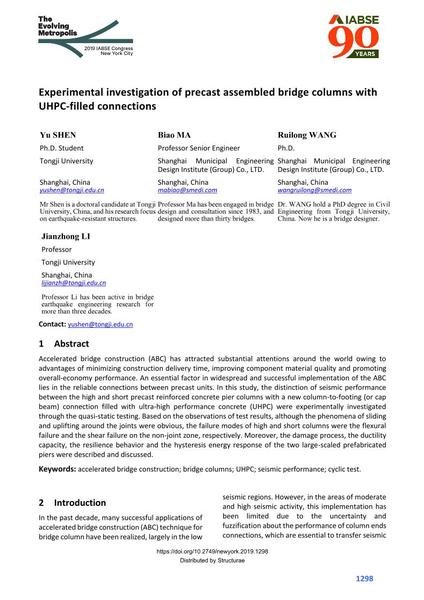Experimental investigation of precast assembled bridge columns with UHPC-filled connections

|
|
|||||||||||
Bibliografische Angaben
| Autor(en): |
Yu Shen
(Tongji University)
Biao Ma (Shanghai Municipal Engineering Design Institute (Group) Co., LTD.) Ruilong Wang (Shanghai Municipal Engineering Design Institute (Group) Co., LTD.) |
||||
|---|---|---|---|---|---|
| Medium: | Tagungsbeitrag | ||||
| Sprache(n): | Englisch | ||||
| Tagung: | IABSE Congress: The Evolving Metropolis, New York, NY, USA, 4-6 September 2019 | ||||
| Veröffentlicht in: | The Evolving Metropolis | ||||
|
|||||
| Seite(n): | 1298-1304 | ||||
| Anzahl der Seiten (im PDF): | 7 | ||||
| DOI: | 10.2749/newyork.2019.1298 | ||||
| Abstrakt: |
Accelerated bridge construction (ABC) has attracted substantial attentions around the world owing to advantages of minimizing construction delivery time, improving component material quality and promoting overall-economy performance. An essential factor in widespread and successful implementation of the ABC lies in the reliable connections between precast units. In this study, the distinction of seismic performance between the high and short precast reinforced concrete pier columns with a new column-to-footing (or cap beam) connection filled with ultra-high performance concrete (UHPC) were experimentally investigated through the quasi-static testing. Based on the observations of test results, although the phenomena of sliding and uplifting around the joints were obvious, the failure modes of high and short columns were the flexural failure and the shear failure on the non-joint zone, respectively. Moreover, the damage process, the ductility capacity, the resilience behavior and the hysteresis energy response of the two large-scaled prefabricated piers were described and discussed. |
||||
| Stichwörter: |
UHPC
|
||||
